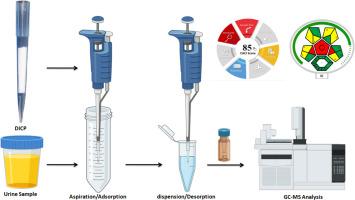Disposable in-tip cellulose paper device functionalized with clove essential oil for green and efficient extraction of abusable prescription drugs
IF 3.2
引用次数: 0
Abstract
A novel, green, and cost-effective microextraction method based on a disposable-in-tip cellulose paper (DICP) device was developed for the determination of three commonly abused prescription drugs; dextromethorphan (DXM), tramadol (TRM), and clozapine (CLZ); in human urine samples. The DICP device was fabricated by dip-coating cellulose paper with 1 % clove essential oil (CEO), which imparts amphiphilic properties to the cellulose surface, enhancing its sorptive interaction with analytes of moderate polarity. The extraction was carried out using 50 manual aspiration–dispensing cycles, followed by 40 aspiration–dispensing cycles for desorption of target analytes with 500 µL of methanol. The proposed method is extremely cost-effective and high-throughput, enabling the preparation of 12 samples per hour, with 30 extraction strips obtained from a single cellulose disc. The mechanism of extraction relies on the synergistic interaction between cellulose hydroxyl groups and the eugenol-rich CEO layer, facilitating the adsorption of analytes through combined hydrophilic and hydrophobic interactions. The method demonstrated excellent analytical performance, with limit of quantifications (LOQs) between 0.06–0.09 µg mL-1, linearity (R² > 0.994), intra-day and inter-day precision below 7 % and 13 %, respectively, and accuracy ranging from 86 to 110 %. Blind urine sample analysis confirmed the method’s reliability for real-world application. Furthermore, the protocol achieved a click analytical chemistry index (CACI) score of 85 and a ComplexMoGAPI score of 83, highlighting its outstanding greenness, simplicity, and field-deployability for forensic and toxicological applications.

用丁香精油功能化的一次性尖端纤维素纸装置,绿色高效地提取可滥用的处方药
基于一次性尖端纤维素纸(DICP)装置,建立了一种新型、绿色、经济高效的微萃取方法,用于检测三种常见的处方药。右美沙芬(DXM)、曲马多(TRM)、氯氮平(CLZ);在人类尿液样本中。采用1%丁香精油(CEO)浸渍涂布纤维素纸制备了DICP装置,使纤维素表面具有两亲性,增强了其对中极性分析物的吸附作用。人工抽提50次,然后用500µL甲醇对目标物进行40次抽提解吸。所提出的方法具有极高的成本效益和高通量,每小时可以制备12个样品,从单个纤维素圆盘上获得30个提取条。萃取机理依赖于纤维素羟基与富含丁香酚的CEO层之间的协同作用,通过亲疏水结合的相互作用促进分析物的吸附。定量限(loq)在0.06 ~ 0.09µg mL-1之间,线性(R²>;0.994),日内、日间精密度分别低于7%和13%,准确度在86% ~ 110%之间。盲法尿样分析证实了该方法在实际应用中的可靠性。此外,该方案的点击分析化学指数(CACI)得分为85分,ComplexMoGAPI得分为83分,突出了其出色的绿色、简单性和法医和毒理学应用的现场部署能力。
本文章由计算机程序翻译,如有差异,请以英文原文为准。
求助全文
约1分钟内获得全文
求助全文
来源期刊

Journal of chromatography open
Analytical Chemistry
CiteScore
2.50
自引率
0.00%
发文量
0
审稿时长
50 days
 求助内容:
求助内容: 应助结果提醒方式:
应助结果提醒方式:


